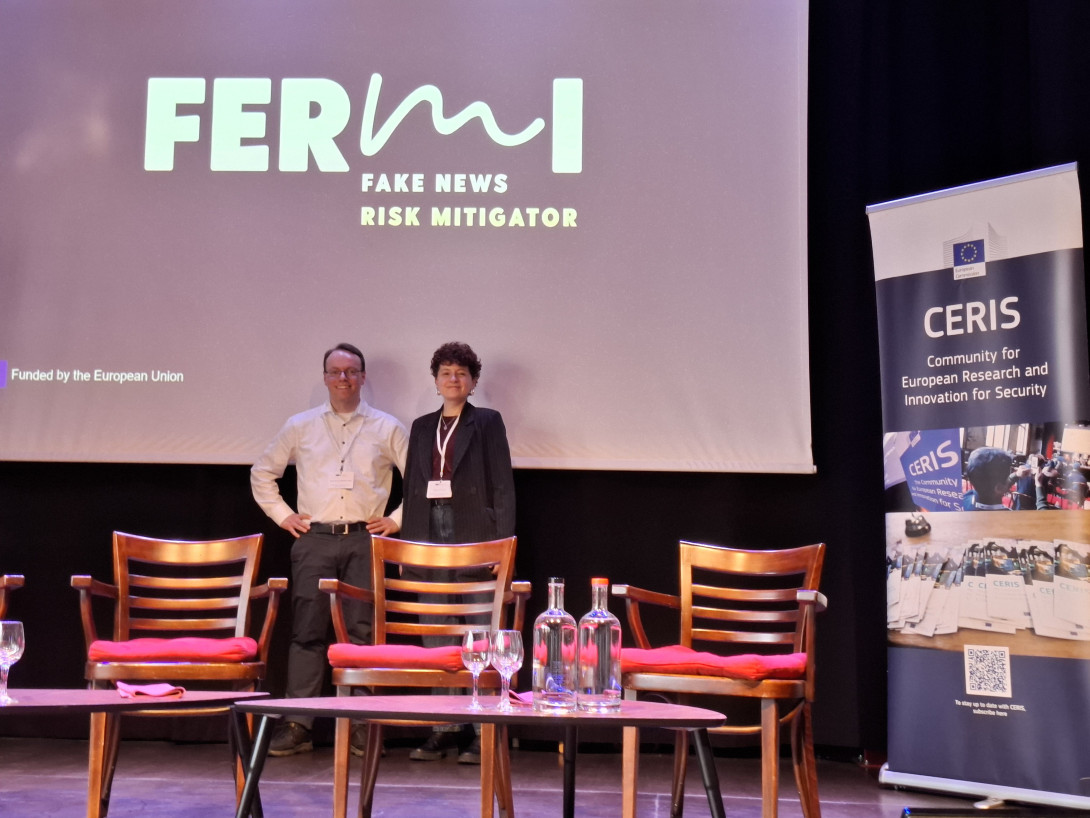
The FERMI consortium participated in two consecutive meetings organised by the Community for European Research and Innovation for Security (CERIS) in Brussels. The first gathering titled “Countering online identity theft and fake information” was held on 15 May 2025, whereas the “Disaster Resilience Days” took place from 19-21 May 2025.
Panel Discussions with FERMI’s Participation
The meeting on “Countering online identity theft and fake information” included a panel on “Strategies for Mitigating Online Identity Theft and Disinformation,” which Flavia Giglio (KU Leuven), FERMI’s legal and ethics expert, attended alongside her colleague Abdullah Elbi, Ross King (AIT) and Dr Carolina Scarton (University of Sheffield). The panel was moderated by Michele Socco from DG Home. Flavia Giglio gave an overview of the challenges of delineating the fairly controversial term ‘disinformation’ and legally regulating the deliberate spread of false allegations. In turn, along with the other panellists, she discussed how disinformation can overlap with identity theft, as well as the common strategies and regulatory solutions to combat these two phenomena in the online environment.
On the first day of the “Disaster Resilience Days” Sven-Eric Fikenscher from the Bavarian Police Academy (BPA) presented the FERMI project and discussed its contribution to making societies resilient against disinformation and the ramifications thereof in a panel on “Societal Resilience - Engage, inform, empower: cocreating risk communication strategies.” Nathan Clark (LINKS project) moderated the discussion, which was joined by Alessia Golfetti (SYNERGIES project) and Maike Wollmer (RISKPACC project). In the remarks on FERMI a strong emphasis was placed on providing law-enforcement agencies (LEAs) and civil society alike with the knowledge to understand the disinformation threat. LEAs are also the target audience of the FERMI platform, which includes tools aimed at stemming the tide of deliberately shared false claims.
Demonstration of the FERMI Platform
Sven-Eric Fikenscher also demonstrated said platform during the first gathering with the help of a video that had been prepared by FERMI’s technical manager, Information Technology for Market Leadership (ITML). Besides FERMI, our sister project VIGILANT as well as EITHOS and ECTEG also did demonstrations.
In accordance with the FERMI platform’s focal points, the demo placed a special emphasis on
- enhancing investigations,
- assessing threats and impacts and
- proposing actionable counter-measures.
The FERMI platform is composed of different tools that help LEAs tackle these challenges. In particular, a Spread Analyser captures the dissemination of social media messages of concern, distinguishes between human- and bot-operated accounts and grasps the accounts’ influence, which enables LEAs to identify further suspects, figure out if those can be investigated or if the message (if shared by a bot-operated account) needs to be traced back further until a human-operated account can be identified, and collect evidence.
Threat assessments can be carried out thanks to a Sentiment Analysis module, a Dynamic Flows Modeler and a Swarm Learning framework. The Sentiment Analysis module measures whether a social media post is informed by positive, negative or neutral sentiments, which gives LEAs an early indication as to whether or not some tension might be brewing, whereas the Dynamic Flows Modeler with the help of a Swarm Learning framework estimates the crime landscape in the aftermath of a disinformation campaign. The impact of said crimes is measured in terms of costs by the Behaviour Profiler and Socioeconomic Analyser. In the event those are deemed moderate or higher, counter-measures are proposed by the Community Resilience Management Modeler.